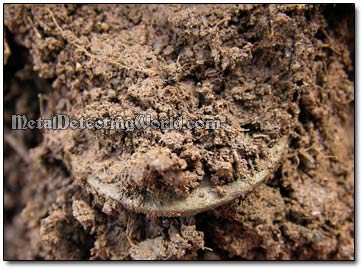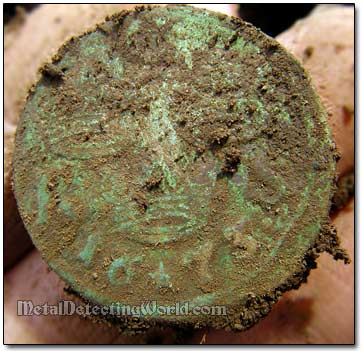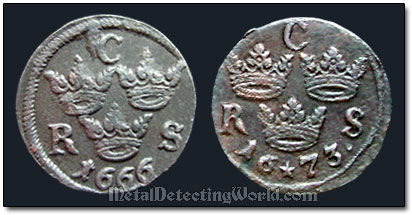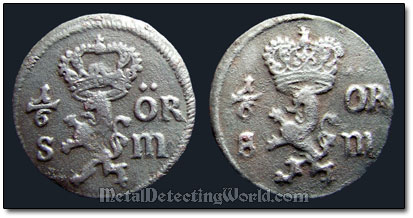Part I - Metal Detecting at the Swedish Tavern Site, page 22
Varieties of Halvöring 1/6 Öre Coin
I began metal detecting at the spot where there previously was the highest concentration of good signals. Now I could hear only the low-pitched "grunting" of rusty square nails. Because this was my first time with E-Trac, I did not know how the coin positioned under the nail would sound in reality...
But I knew the theory: there would be a fraction of high-pitched sound at the end of a bad signal. According to the manual, "the detector will lock onto the coin, and the target ID for the coin will be displayed at the end of detection" (page 73 of the Instruction Manual). Because I do not look at the display while metal detecting, my decision making is solely depends on audio. After eight years of using the Explorers, I have trained my ears to hear the slightest variations in sounds.
...I was listening to the bad signals very carefully, and suddenly I heard the one that got me interested. 2/3 of the "one-way" signal sounded with a high-pitched tone, though this good fraction did not sound continuously. It was rather faltering all the way (how I made the signals of this nature sound less faltering will be described below). I dug the dirt plug out and noticed a rusty iron square nail in it.
Rusty Nail Recovered

There were no more signals in the dirt plug. Hmm... now I was wondering if what Minelab claimed about the E-Trac was true. The moment of truth had come! I scanned the hole and got... a solid coin signal! Wow. Unbelievable! I looked into the hole and spotted the coin's edge sticking out of dirt.

It was 1673 1/6 Öre coin. Right away I noticed that the coin's reverse design slightly differed from the reverse design of the 1666 1/6 Öre coins: the date was divided by a star.

Swedish 1673 1/6 Öre Coin

Just like the 1/4 Öre coins of different dates but of the same period, the 1/6 Öre coins had a few differences in both the reverse and obverse designs depending on the date of issuance. But they were all produced at the same Avesta mint. As I found out later, there were only two varieties of the 1/6 Öre coins ever produced. By the way, the 1/6 Öre coin was called a "Halvöring" among the Swedes.
Two Varieties of Reverse Designs of Swedish 1/6 Öre Coins

There was a shortage of silver, but plenty of copper extracted at the Falu copper mine in Sweden in the 17th century. Therefore the coin mintage was shifted to the copper coins, but their purchasing power was like of silver coins. This is what the abbreviation "sm" on the obverse means - "silvermynt," i.e. there is enough copper in the coin to be equal to the silver coin in value. This caused the copper coins to be much larger and heavier than silver coins.
Two Varieties of Obverse Designs of Swedish 1/6 Öre Coins
